Why do we have Christmas trees? Plus, the origins behind other Christmas traditions
Ever wondered why we put tinsel on Christmas trees? Or why we eat mince pies?


Have you ever wondered why do we have Christmas trees? As we look at the origin of the festive tradition.
From the 12 days of Christmas to hanging mistletoe above the door, there are so many Christmas traditions families follow each year to help them get into the festive spirit.
Another big part of the season of giving for many of us is putting up the Christmas tree - and taking it down - and whether you to the local Christmas tree farm to pick a tree or prefer to pick a rented Christmas tree instead. Bat some point, you or your kids have probably been wondering why do we have Christmas trees? Well we have all the answers...
Why do we have Christmas trees?
Christmas trees were first used by pagans, who used branches to decorate their homes during the winter to celebrate the coming of spring, meaning evergreen fir trees have been used to celebrate winter festivals for thousands of years.
While pagans used the branches of evergreen trees around the time of winter solstice to bring life to the dark winter days, the ancient Romans used fir trees to decorate their temples during the festival of Saturnalia. According to English Heritage, Saturnalia was one of the many Roman festivals and it started as a one-day event to honour Saturn, the Roman god of farming and the harvest.
It was held on 17 December, with traditionally young pigs, sacrificed at a temple dedicated to Saturn were eaten the next day during a public feast. This one-day event was extended to a week-long festival from 17-23 December.
Meanwhile, Christians see Christmas trees as a sign of everlasting life with God.
GoodtoKnow Newsletter
Parenting advice, hot topics, best buys and family finance tips delivered straight to your inbox.

But the traditional Christmas tree as we know it became popular thanks to a man named Martin Luther, a 16th-century Protestant reformer. According to the story, the preacher was walking through a forest and saw the stars shining through the branches - and he was so inspired he took a tree home to try and recreate the scene.
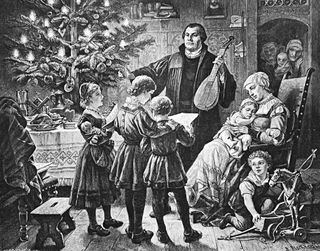
The tradition originated in Germany, and was introduced in England for the first time when King George III was on the throne. King George III had a German wife, and it is believed she used to decorate a tree for her family in the 1790s.
This tradition was continued by the British Royal Family, and it became particularly popular in England during Victorian times, when Prince Albert - who was born in Germany - would bring a Christmas tree into the royal household and decorate it each year. Ever since then, the fir tree has been an iconic Christmas symbol and can be found in public places, town centres and homes during the festive period.
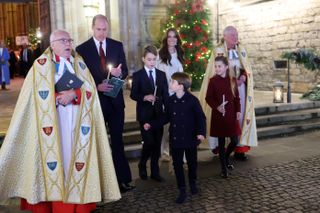
Why do we decorate Christmas trees?
Martin Luther also started the tradition for decorating trees after he put candles on the tree he took, to make it look like stars were shining through. In 1895, Ralph Morris developed electric lights as an easier (and safer!) alternative, after seeing his son push a candle over and nearly set the tree and house on fire, according to Oldchristmastreelights.com. He started by pulling the lights from an old telephone switchboard and wiring them on a tree and the rest is history.
Meanwhile, Christmas baubles first originated in Germany after 'trees of paradise' were decorated with red apples for the miracle plays which took place outside the church on Christmas Eve. These soon became the baubles we know and use today.

Christmas tree decorations became fashionable in the UK during Queen Victoria’s reign, after a photograph was published in 1848 which saw the Royal Family posing next to a large tree decorated with elaborate ornaments.
As for tinsel, that was invented in Germany in the early 1600s and was originally made of strips of sliver and other metals. It used to be used to decorate sculptures before becoming associated with Christmas trees, so it's always been used to add a bit of sparkle to festive decorations.
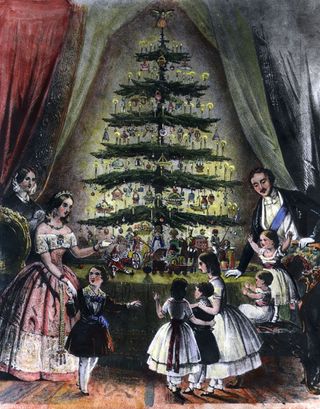
The origins of other Christmas traditions
Why do we eat mince pies?
Mince pies were originally filled with meat rather than dried fruit and were made in the shape of an oval to represent Jesus' manger in the nativity story. In Stuart and Georgian times mince pies became a symbol of wealth and rich people liked to show them off at Christmas parties.
According to a tradition from the Middle Ages, if you eat mince pies every day from Christmas Day until the 12th night, you'll be happy for the next year. Now that's something we're up for trying!
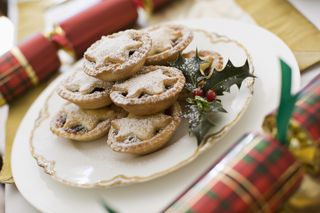
Why are we meant to kiss under the mistletoe?
Mistletoe was thought to be used by druids to ward off evil spirits and so was brought into the house. According to Norse mythology, mistletoe was a sign of love and friendship, which led to the custom of kissing underneath it. The original tradition stated that you had to pick a sprig of mistletoe before someone could be kissed. When all the berries had gone, that marked the end of the kissing!
We've kept up this tradition to this day, with many people choosing to hang mistletoe in their homes over the festive season. As well as being a sweet tradition, it's also a lovely decoration!

Why do we eat turkey?
Before turkey first came to the UK over 500 years ago, the Christmas meat of choice was often goose, boar or even peacock. However, farmers decided it would be more cost-effective to keep their other animals alive so they could keep producing eggs and milk.
Henry VIII was the first person to eat turkey on Christmas Day, but it was only made popular after Edward VIII adopted the tradition. And we've been filling our faces with it ever since! Nowadays, it is estimated that around 10 million turkeys are eaten in the UK every year.
Where did Father Christmas come from?
Jolly old St Nick is actually inspired by real-life St Nicholas. According to the legend, St Nicholas dropped a bag of gold down the chimney of a poor man's house to help pay a dowry for his three daughters. But the bag of gold didn't land in the fireplace and instead fell into some stockings, which had been hung by the fire to dry. (This is also where we get the tradition for hanging up stockings!)
St Nicholas repeated this and sent more money down the chimney for the second daughter. The third time, the father waited by the chimney to see who was helping his family, but St Nicholas did not want anyone to find out and bring attention to himself. However, the rumour spread and soon people thought that when anyone received a secret gift it was from St Nick!

Why do we give each other presents?
In the nativity story, the three wise men brought gifts of gold, frankincense and myrrh - and that tradition of gift-giving has stuck.
While most children believe in a magical person who delivers Christmas toys and presents, this varies depending on the country. While some kids ask is Santa Claus real?, children in the UK believe in Father Christmas and, in Germany, it's Christkind. In Spain it's the Wise Men and in Italy it's an old lady called Befana.
Why do we have Christmas pudding?
One of our favourite Christmas desserts actually originated way back in the 14th century. It was originally a porridge called 'frumenty', which was a mixture of beef, mutton, raisins, currants, prunes, wine and different spices. It was eaten just before Christmas as a fasting meal in preparation for the big day.
The treat eventually turned into a plum pudding and by 1650 it became a customary Christmas dessert, while the Victorians would eat something very similar to the Christmas pudding we have today!
In other Family news you might be wondering will it snow in the UK? or you might like to know the best places to hide Christmas presents from kids if you don't want them to find them until Christmas morning.

Selina is a Senior Family Writer for GoodtoKnow and has more than 16 years years of experience. She specialises in royal family news, including the latest activities of Prince George, Charlotte, Louis, Archie and Lilibet. She also covers the latest government, health and charity advice for families. Selina graduated from the University of Sheffield in 2006 with a degree in Journalism, and gained her NCTJ and NCE qualifications. During her career, she’s also written for Woman, Woman's Own, Woman&Home, and Woman's Weekly as well as Heat magazine, Bang Showbiz - and the Scunthorpe Telegraph. When she's not covering family news, you can find her exploring new countryside walking routes, catching up with friends over good food, or making memories (including award-winning scarecrows!)
-
 How to play with Barbie dolls: 6 ways to use the iconic doll as a positive role model at home
How to play with Barbie dolls: 6 ways to use the iconic doll as a positive role model at homeIf you have a little one who loves to play with Barbie, there are lots of positive ways in which you can encourage them to play in a way that helps their development and self-esteem. We’ll show you how.
By Joanne Lewsley Published
-
 Think you're raising a mini-me? It's actually unlikely your child will inherit your personality and could have a temperament closer to a 'random stranger', according to new study
Think you're raising a mini-me? It's actually unlikely your child will inherit your personality and could have a temperament closer to a 'random stranger', according to new studyIf you often hear the phrase 'like mother like daughter,' or 'like father like son,' research suggests you're actually only slightly more likely to share familial traits than with strangers.
By Lucy Wigley Published
-
 40 naughty Elf on the Shelf ideas that are so easy to copy for Christmas 2023
40 naughty Elf on the Shelf ideas that are so easy to copy for Christmas 2023Need some naughty Elf on the Shelf ideas? We've got you covered, and not in honey like some naughty elves might do...
By Stephanie Lowe Last updated
-
 John Lewis predicts these are the 10 must-have toys for Christmas 2023
John Lewis predicts these are the 10 must-have toys for Christmas 2023The retailer has spoken! John Lewis reckons these are the toys to snap up before they sell out
By Heidi Scrimgeour Published
-
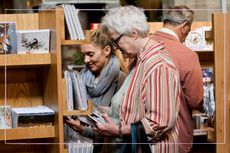 Charity Christmas Cards to buy in 2022: Cards For Good Causes charity opens over 100 Christmas pop-up shops
Charity Christmas Cards to buy in 2022: Cards For Good Causes charity opens over 100 Christmas pop-up shopsIf you're looking for charity Christmas cards to buy in 2022, check out Cards for Good Causes, the Christmas card retailer that allows you to choose which charity your money goes to
By Ellie Hutchings Published
-
 Will we have a White Christmas in the UK? 2023 odds and Met Office predictions
Will we have a White Christmas in the UK? 2023 odds and Met Office predictionsIt would be the first properly white Christmas in the UK in 13 years
By Ellie Hutchings Last updated
-
 Best Christmas jumpers 2022: 31 of the best festive knits for women, men and teenagers
Best Christmas jumpers 2022: 31 of the best festive knits for women, men and teenagersAll the best Christmas jumpers for 2022
By Emily Stedman Last updated
-
 When to take your Christmas tree down - the tradition explained
When to take your Christmas tree down - the tradition explainedIf you want to know when to take your Christmas tree down and if it's bad luck to take it down at the wrong time, we've delved into the tradition to find out the answer
By Ellie Hutchings Last updated
-
 What does the shape of a candy cane represent?
What does the shape of a candy cane represent?Find out what does the shape of a candy cane represent and why they are associated with Christmas
By Ellie Hutchings Published
-
 The 12 best Christmas crackers 2022 - for all budgets
The 12 best Christmas crackers 2022 - for all budgetsWe've rounded up the 12 best Christmas crackers to add a touch of magic to your table
By Mollie Davies Published